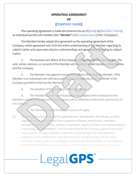What to Do When You Discover an Employee is Secretly Working for a Competitor
You’re scrolling through LinkedIn when you spot a post: your top salesperson, still on your payroll, is boasting about their new role at a rival...
7 min read
LegalGPS : Jul. 22, 2025
Imagine this: your top salesperson, who knows your clients and strategies inside out, quits your startup and launches a rival company across town. You hear they’re emailing your customers, offering lower prices, and maybe even using your proprietary methods. Suddenly, your business is losing clients, and you’re wondering how to fight back. When a former employee starts a competing business, it’s not just a betrayal—it’s a threat to your revenue, reputation, and trade secrets.


Legal GPS Pro
Protect your business with our complete legal subscription service, designed by top startup attorneys.
This guide walks you through what to do when a former employee becomes a competitor, offering a clear, actionable plan to protect your business. From reviewing contracts to strengthening client loyalty, we’ll cover five key steps, complete with real-world examples and practical “Pro Tips” to help you act fast and smart. Whether you’re a freelancer, startup founder, or small business owner, let’s safeguard your business.
Your first move is to check whether the former employee signed any agreements that restrict their ability to compete. Non-compete, non-solicitation, and confidentiality clauses can limit what ex-employees can do, but their enforceability depends on the contract’s terms and your state’s laws.
Start by pulling the employee’s contract. Look for a non-compete clause, which might prohibit them from starting a similar business within a certain time (e.g., one year) or geographic area (e.g., 50 miles). Non-solicitation clauses can prevent them from contacting your clients or poaching other employees. Confidentiality agreements (NDAs) protect trade secrets, like pricing strategies or client lists. If you don’t have a signed contract, you may have limited legal options, but verbal agreements or employee handbooks might still apply in some cases.
Next, assess whether the clauses are enforceable. State laws vary widely—California, for example, bans most non-competes under Business and Professions Code Section 16600, while states like Texas or Florida allow them if they’re reasonable in scope. A lawyer can help interpret vague terms or confirm if your contracts hold up in court.
Sarah owned a popular bakery and was shocked when her head baker, Tom, left to open a rival shop nearby. Digging through Tom’s employment contract, she found a non-compete clause barring him from starting a bakery within 25 miles for two years. Since her state enforced reasonable non-competes, Sarah’s lawyer sent a letter reminding Tom of the clause, prompting him to relocate his shop outside the restricted area. Without that contract, Sarah might have lost half her customers.
Store all employment agreements in a secure digital system, like Google Drive or a dedicated HR platform. Organize files by employee name and include a master list of who signed what. This setup lets you quickly find contracts when issues arise, saving time and stress in a crisis.
Before taking action, evaluate how the former employee’s business is affecting yours. Are they actively soliciting your clients, using your trade secrets, or targeting your market? Understanding the threat helps you prioritize your response and gather evidence for potential legal steps.
Start by identifying their actions. Check if they’re contacting your clients—look for emails, social media posts, or ads targeting your customer base. If they’re using proprietary information, like a unique process or client list, that’s a red flag for trade secret theft. You can also review their website or marketing materials to see if they’re mimicking your branding or offerings.

Noncompetition Agreement (Employee)
Explore the essentials of Employee Noncompete Agreements to prevent competition and protect your business interests.
Trusted by 1,000+ businesses to safeguard their LLCs.
Gather evidence discreetly. Save emails from clients mentioning the ex-employee’s outreach, screenshot their ads, or note conversations where they reference your methods. Estimate the financial impact—losing one major client might cost $10,000 annually, while losing trade secrets could cripple your competitive edge. This assessment guides whether you pursue legal action or focus on retaining customers.
TechTrend, an IT consulting firm, noticed a drop in clients after a former developer, Lisa, started a competing business. Clients mentioned receiving emails from Lisa offering similar services at a discount. TechTrend’s owner saved the emails, documented overlapping service descriptions on Lisa’s website, and calculated a $15,000 revenue loss. This evidence strengthened their case for a cease-and-desist letter, which stopped Lisa’s solicitations.
Set up Google Alerts for the ex-employee’s business name and key terms like your industry or city. Follow their social media accounts (without engaging) to track promotions or client outreach. This low-cost monitoring helps you spot threats early and collect evidence without escalating the situation.
If the former employee is violating a contract or stealing trade secrets, legal action may be necessary. The goal is to stop their behavior and minimize damage, but legal steps require careful planning to avoid wasting time or money.
Start with a cease-and-desist letter. This formal notice, drafted by a lawyer, cites the breached agreement (e.g., non-compete, NDA) and demands the employee stop specific actions, like soliciting clients. It’s often enough to resolve the issue without court. Expect to pay $200–$500 for a lawyer to draft one.
If the employee doesn’t comply, consider a lawsuit. You could sue for breach of contract (e.g., violating a non-compete) or misappropriation of trade secrets under laws like the Defend Trade Secrets Act. Lawsuits are expensive—$10,000 or more—so weigh the costs against the damage. For example, losing a $50,000 client might justify litigation, but a minor client loss might not. Check state laws, as some limit non-compete enforcement or require specific evidence for trade secret claims.
GreenLeaf Landscaping faced trouble when a former manager, Jake, started a rival company and used GreenLeaf’s pricing model. Jake’s contract included an NDA protecting pricing data. GreenLeaf’s attorney sent a cease-and-desist letter, citing the NDA and demanding Jake stop using their strategies. Jake complied, avoiding a lawsuit and saving GreenLeaf’s competitive edge.
Hire an employment law attorney to review your contracts and evidence before sending a cease-and-desist or filing a lawsuit. They’ll assess whether your claims are enforceable and recommend the best approach. A one-hour consultation (around $200–$400) can prevent costly legal missteps.
Legal action isn’t always the full solution—proactively retaining clients and employees can limit the ex-employee’s impact. A strong customer base and loyal team are your best defense against competition.
Reach out to clients to reinforce trust. Send personalized emails or call key accounts to reaffirm your commitment to their needs. Highlight what sets you apart, like superior service or unique offerings. Consider incentives, like a 10% discount for renewing a contract early or a loyalty program for repeat customers. These gestures can lock.


Legal GPS Pro
Protect your business with our complete legal subscription service, designed by top startup attorneys.
Offer incentives to employees to stay, like flexible hours, performance bonuses, or clear career paths. Conduct exit interviews to understand why the former employee left and address similar concerns with current staff. A 2023 Gallup study found that engaged employees are 23% less likely to leave, so invest in morale.
FitFusion, a fitness studio, lost clients when a former trainer opened a rival gym. The owner emailed clients, offering a free class and a 15% discount on memberships. They also hosted a “client appreciation day” with free smoothies and mini-workouts, boosting attendance. For staff, FitFusion added a quarterly bonus for top trainers, reducing turnover. These efforts retained 90% of their clients and stabilized the team.
Organize a low-cost event, like a webinar showcasing your expertise or an in-person open house with refreshments. Promote it via email and social media, and use- Use the event to reconnect with clients, answer questions, and highlight your business’s value. This personal touch can solidify loyalty and counter competitor outreach.
A competing ex-employee is a wake-up call to tighten your business’s protections. Update your policies and contracts to minimize future risks, balancing legal limits with practical safeguards.
Revise employment agreements to include stronger non-compete, non-solicitation, and NDA clauses, but keep them reasonable to ensure enforceability. For example, a one-year non-compete within 25 miles is more likely to hold up than a five-year global ban. Have a lawyer draft or review templates to comply with state laws.
Protect trade secrets by limiting access to sensitive data. Use password-protected files, restrict client lists to key staff, and monitor data downloads. Train employees on confidentiality during onboarding, emphasizing real-world examples of trade secret theft. Regular training reinforces compliance without overwhelming staff.
InnovateTech, a software firm, faced competition from an ex-developer who used their code snippets. Post-incident, they updated NDAs to explicitly cover source code and limited access to their GitHub repository. They also added a 30-minute confidentiality training to onboarding, using case studies to show the harm of leaks. These changes cut data risks and boosted employee awareness.
Schedule an annual review of employment agreements with a lawyer to ensure they align with current laws and your business’s growth. Check for outdated clauses or new state regulations, like non-compete bans. This hour-long review (around $200) keeps your contracts bulletproof and relevant.
When a former employee starts a competing business, it’s a test of your resilience and strategy. By following these five steps—reviewing agreements, assessing the threat, taking legal action if needed, strengthening relationships, and updating policies—you can protect your business and come out stronger. Act quickly to limit damage, but stay strategic to avoid costly overreactions.
Start today by pulling your ex-employee’s contract and checking for restrictive clauses. Have you faced a similar situation? Share your story in the comments or reach out with questions. Your business is worth defending—make it unstoppable.
The biggest question now is, "Do you need a lawyer for your business?” For most businesses and in most cases, you don't need a lawyer to start your business. Instead, many business owners rely on Legal GPS Pro to help with legal issues.
Legal GPS Pro is your All-In-One Legal Toolkit for Businesses. Developed by top startup attorneys, Pro gives you access to 100+ expertly crafted templates including operating agreements, NDAs, and service agreements, and an interactive platform. All designed to protect your company and set it up for lasting success.

Legal GPS Pro
Protect your business with our complete legal subscription service, designed by top startup attorneys.
|
Premium Template
Single-use Template |
Legal GPS Pro
Unlimited Access, Best Value |
|
|
| Choose Template | Learn More |
| Trusted by 1000+ businesses | |

You’re scrolling through LinkedIn when you spot a post: your top salesperson, still on your payroll, is boasting about their new role at a rival...

You took the right step: you had someone sign a Non-Disclosure Agreement (NDA) to protect your confidential information. But now you’ve discovered...

You’re sipping coffee when an employee confesses: they accidentally emailed a spreadsheet with client Social Security numbers to the wrong recipient....